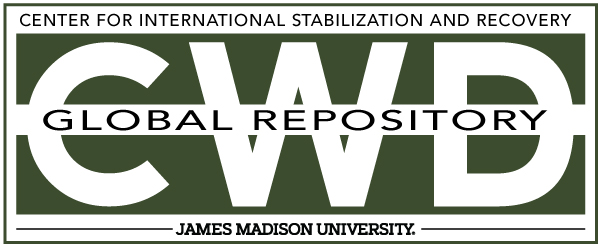Document Type
Other
Creative Commons License

This work is licensed under a Creative Commons Attribution-Noncommercial-No Derivative Works 4.0 License.
Publication Date
7-2011
Keywords
TWEIS, 2010, 10th Edition, Risk Education, Victim Assistance, ERW Clearance, Conventional Weapons Stockpile Destruction, Advocacy and International Law, Centers and Organizations, State Department, Humanitarian Mine Action, Landmine, Clearance, Victim Assistance, Risk Education, Funding, PM/WRA, MANPADS, HMA, Training, Research, Development, PSSM, CISR
Abstract
Welcome to the 10th edition of To Walk The Earth In Safety. Our annual report details the United States’ Conventional Weapons Destruction (CWD) Program, a collaborative effort by the Department of State, Department of Defense, United States Agency for International Development, and the Centers for Disease Control and Prevention of the Department of Health and Human Services. These agencies strive to help countries recover from conflict and create safe, secure environments to rebuild infrastructure, return displaced citizens to their homes and livelihoods, and establish situations conducive to stability, nonviolence, and democracy.
From its initial focus on landmines dating back to 1993, the CWD program has expanded to encompass remediation of all explosive remnants of war, as well as the destruction of excess, loosely secured, or otherwise at-risk small arms and light weapons (SA/LW), including man-portable air-defense systems (MANPADS) and munitions. These programs leverage our longstanding involvement and experience in humanitarian mine action to provide additional assistance to countries recovering from conflict, as well as those struggling to control unstable and unsecure munitions that could spark a new humanitarian crisis, or in the case of MANPADS, can endanger global aviation if these potent weapons fall into the wrong hands.
The United States is proud of its leadership in this area. We continue to be the world’s leading donor to CWD, including humanitarian mine action. In Fiscal Year 2010, the Department of State provided $161.5 million in CWD assistance to 43 countries, which contributed to the extraordinary plummet in annual landmine casualties. Since the inception of the U.S. Humanitarian Mine Action Program, we have contributed more than $1.9 billion in CWD assistance to 81 countries, helping several of them become free from the humanitarian impact of landmines in the process. We are proud to have played a part in Central America’s 2010 declaration that it has become mine-impact free, the first region in the world to do so. Our Quick Reaction Force also assisted with clearing abandoned and unexploded munitions left over from World War II in Torokina, Papua New Guinea, thereby returning the land to Torokina residents in 2010.
This work is not done in a vacuum. Extensive efforts to partner with other donor nations, international organizations, and affected states are a hallmark of our CWD Program. The United States also engages in multilateral fora to enact stricter controls on conventional SA/LW, MANPADS, and munitions. This year, the United States has joined with Australia, Canada, New Zealand, and the United Kingdom to form a new initiative aimed at countering the illicit proliferation of MANPADS. In addition to diplomatic engagements, the Department of State reaches out to civil society, both at home and abroad, to raise the profile of these important issues and encourage grassroots involvement in hastening an end to these challenges. Our strong Public-Private Partnership Program enables us to extend our reach and enables dedicated individuals to play a role in improving the lives of their fellow global citizens.
Thanks to support from the U.S. Congress and American taxpayers, we are sustaining American leadership and values in forging ahead with diplomacy and development to help everyone walk the Earth in safety.
Included in
Defense and Security Studies Commons, Peace and Conflict Studies Commons, Public Policy Commons, Social Policy Commons



